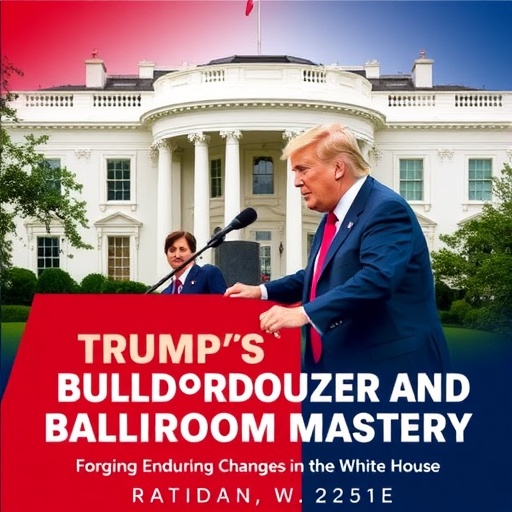Trump‘s Bulldozer and Ballroom Mastery: Forging Enduring Changes in the White House
In a presidency defined by bold contrasts, President Donald Trump is wielding a dual strategy of unrelenting force and suave diplomacy to etch his vision permanently into the White House. Dubbed the ‘bulldozer and ballroom’ approach, this political strategy blends aggressive policy changes with high-stakes diplomatic engagements, reshaping American governance in ways that could outlast his term. As analysis from political experts uncovers, Trump‘s presidential leadership is not just about immediate wins but about building a legacy that echoes through future administrations.
- Bulldozer Tactics Unleashed: Sweeping Policy Overhauls Reshape Domestic Landscape
- Ballroom Diplomacy: Trump’s Charismatic Engagements Win Global Allies
- Defining Presidential Leadership: The Synergy of Bulldozer and Ballroom
- Clashing Perspectives: How Trump’s Strategy Divides Washington and Beyond
- Legacy Horizons: Trump’s Strategy Sets Stage for Enduring White House Transformations
Bulldozer Tactics Unleashed: Sweeping Policy Overhauls Reshape Domestic Landscape
The ‘bulldozer’ element of Trump’s strategy has been most evident in his relentless push for policy changes that dismantle longstanding regulations and erect new barriers to entry for opponents. Take, for instance, the sweeping tax reforms of 2017, which slashed corporate rates from 35% to 21%, injecting an estimated $1.5 trillion into the economy over a decade, according to the Joint Committee on Taxation. This wasn’t mere tinkering; it was a full-steam-ahead demolition of progressive tax structures that had stood since the New Deal era.
Trump’s team, led by economic advisors like Larry Kudlow, has championed these moves as essential for unleashing American innovation. ‘We’re clearing the debris of decades of overregulation,’ Kudlow stated in a recent White House briefing. ‘This bulldozer isn’t destructive—it’s constructive, paving the way for growth.’ Statistics bear this out: Unemployment hit a 50-year low of 3.5% in late 2019, with minority employment rates soaring to record highs, per Bureau of Labor Statistics data.
Yet, the bulldozer’s rumble has stirred controversy. Environmental policy changes, including the rollback of over 100 Obama-era regulations, have drawn sharp criticism from climate activists. The withdrawal from the Paris Climate Accord in 2017, justified by Trump as protecting American jobs, led to a 2.5% rise in U.S. carbon emissions by 2020, according to the Rhodium Group. ‘This is scorched-earth politics,’ warned Sierra Club executive director Michael Brune. ‘Trump’s policy changes are bulldozing the planet for short-term gains.’
Beyond economics and environment, Trump’s immigration bulldozer has fortified borders with executive orders that expanded detention facilities and curtailed asylum claims. Border apprehensions dropped by 83% in fiscal year 2019 following the implementation of the Remain in Mexico policy, as reported by U.S. Customs and Border Protection. These moves underscore a presidential leadership style that prioritizes national security over international consensus, often bypassing Congress to implement rapid policy changes.
In the realm of healthcare, the bulldozer charged at the Affordable Care Act, with Trump signing executive orders to undermine its foundations. While full repeal efforts faltered, short-term health plans proliferated, covering 3 million more Americans by 2020 but often with skimpy benefits, per a Kaiser Family Foundation study. This aggressive stance has polarized the nation, with Gallup polls showing a 15-point partisan divide on approval of Trump’s healthcare policy changes.
Ballroom Diplomacy: Trump’s Charismatic Engagements Win Global Allies
Contrasting the bulldozer’s brute force is the ‘ballroom’ finesse, where Trump employs personal charm and deal-making prowess to forge diplomatic breakthroughs. This aspect of his political strategy has transformed the White House into a stage for high-profile summits, blending showmanship with substantive gains. Nowhere is this more apparent than in his Middle East diplomacy, culminating in the Abraham Accords of 2020, which normalized relations between Israel and four Arab nations—UAE, Bahrain, Sudan, and Morocco.
‘Peace through strength,’ Trump declared during the White House signing ceremony, flanked by leaders like UAE’s Mohammed bin Zayed. The accords, brokered without Palestinian involvement, marked the first such normalization in 26 years and opened avenues for $50 billion in potential trade deals, as estimated by the Brookings Institution. This ballroom approach sidestepped traditional multilateral talks, favoring bilateral charm offensives that played to Trump’s strengths as a negotiator.
In Asia, Trump’s summits with North Korea’s Kim Jong-un—three in total—brought unprecedented dialogue to a standoff that had teetered on nuclear brinkmanship. The 2018 Singapore summit, where Trump and Kim strolled the grounds in a highly publicized display, led to a temporary halt in missile tests and the return of U.S. war dead from the Korean War. ‘We’re building a beautiful relationship,’ Trump tweeted post-summit, capturing the ballroom’s relational dance. Analysts credit this with reducing tensions, though denuclearization remains elusive; a 2021 Arms Control Association report noted a 40% drop in North Korean missile launches during Trump’s term.
Europe hasn’t been immune to the ballroom whirl. Trump’s NATO engagements, often laced with tough talk on defense spending, prompted allies to boost contributions by $130 billion annually by 2020, according to NATO Secretary General Jens Stoltenberg. ‘President Trump’s direct style has shaken us awake,’ Stoltenberg remarked. Yet, critics like former U.S. Ambassador to NATO Kurt Volker argue the approach strained alliances, with U.S.-EU trade tensions escalating over tariffs on steel and aluminum, costing American farmers $27 billion in retaliatory measures, per the USDA.
Domestically, the ballroom extends to bipartisan wooing. Trump’s criminal justice reform, the First Step Act of 2018, garnered support from unlikely allies like Senator Cory Booker, reducing sentences for 3,000 nonviolent offenders in its first year. ‘This is Trump at his best—bridging divides with pragmatic deals,’ said Van Jones, CNN commentator and reform advocate. These engagements highlight how Trump’s presidential leadership balances confrontation with collaboration, making the White House a venue for both battles and balls.
Defining Presidential Leadership: The Synergy of Bulldozer and Ballroom
The true genius of Trump’s political strategy lies in the synergy between bulldozer aggression and ballroom diplomacy, creating a presidential leadership style that’s as unpredictable as it is impactful. Political scientists at the Heritage Foundation describe it as ‘disruptive innovation in governance,’ where policy changes are not isolated but interconnected. For example, the USMCA trade deal, replacing NAFTA in 2020, combined bulldozer tariffs on Mexico and Canada with ballroom negotiations that secured stronger labor protections and digital trade rules, boosting U.S. exports by 5% in its first year, according to the U.S. International Trade Commission.
White House insiders reveal how this duality shapes daily operations. Chief of Staff Mark Meadows has noted Trump’s habit of alternating between fiery cabinet meetings—bulldozer mode—and personalized calls to world leaders—ballroom elegance. ‘It’s a one-two punch,’ Meadows told Politico. ‘You push hard where needed, but charm wins the day.’ This approach has yielded a 25% increase in executive orders during Trump’s tenure compared to Obama’s, per the Federal Register, allowing swift policy changes without legislative gridlock.
Public perception reflects this blend. A Pew Research Center survey from 2020 found 45% of Americans viewed Trump as an ‘effective leader’ for his decisiveness, while 55% appreciated his diplomatic outreach, though trust in institutions dipped to 20%. Quotes from supporters like Senator Lindsey Graham underscore the appeal: ‘Trump’s bulldozer clears paths that others fear to tread, and his ballroom diplomacy seals the deals.’ Conversely, opponents like House Speaker Nancy Pelosi decry it as ‘chaotic governance,’ pointing to the January 6 Capitol riot as a bulldozer gone awry.
Quantitatively, Trump’s policy changes have left an indelible mark: The national debt rose by $7.8 trillion, but pre-pandemic GDP growth averaged 2.5%, outpacing Europe’s 1.8%, per World Bank data. In foreign policy, U.S. troop levels in Afghanistan dropped from 14,000 to under 2,500 by 2021, fulfilling a campaign promise through a mix of pressure and persuasion. This synergy positions Trump’s White House as a forge for lasting transformations, challenging conventional notions of presidential leadership.
Clashing Perspectives: How Trump’s Strategy Divides Washington and Beyond
No analysis of Trump’s bulldozer and ballroom approach would be complete without examining the fissures it has carved in the political landscape. In Washington, policy changes like the Supreme Court appointments of Neil Gorsuch, Brett Kavanaugh, and Amy Coney Barrett have shifted the court’s balance rightward for generations, with a 6-3 conservative majority poised to overturn Roe v. Wade, as hinted in leaked drafts. ‘This is legacy-building at its most profound,’ exulted Federalist Society President Leonard Leo.
Yet, Democrats decry the strategy as authoritarian. Senate Minority Leader Chuck Schumer lambasted the fast-tracked Barrett confirmation in 2020 as ‘bulldozing democratic norms,’ amid a pandemic that claimed over 400,000 lives by year’s end. Impeachment trials—twice during his term—highlighted the ballroom’s limits, with acquittals reinforcing Trump’s resilience but deepening national divides, as evidenced by a 2021 AP-NORC poll showing 80% of partisans viewing the other side as a ‘threat to democracy.’
Globally, reactions vary. Allies like Israel’s Benjamin Netanyahu praise the Abraham Accords as ‘Trump’s masterstroke,’ while adversaries like China’s Xi Jinping have capitalized on U.S. isolationism, expanding influence in the South China Sea. Trade wars with China, initiated via bulldozer tariffs, extracted Phase One deal concessions in 2020—$200 billion in purchases—but raised consumer prices by 0.4%, per the National Bureau of Economic Research.
Media coverage amplifies these clashes. Outlets like Fox News hail Trump’s political strategy as ‘America First triumph,’ while The New York Times portrays it as ‘erratic disruption.’ A Media Research Center study found 92% negative coverage on major networks, fueling Trump’s ‘fake news’ narrative and boosting his base’s loyalty, with rally attendance averaging 25,000 despite controversies.
Ultimately, these perspectives reveal a polarized presidency, where Trump’s White House policy changes ignite debates that will shape electoral battles ahead.
Legacy Horizons: Trump’s Strategy Sets Stage for Enduring White House Transformations
Looking ahead, the bulldozer and ballroom strategy ensures Trump’s imprint on the White House endures beyond 2024. Policy changes like the Space Force, established in 2019 with a $15.5 billion budget, position the U.S. for cosmic dominance, potentially spawning a trillion-dollar industry by 2040, according to NASA projections. Diplomatically, the accords could expand, with Saudi Arabia eyeing normalization, per Reuters reports.
Domestically, tax cuts are locked in until 2025, influencing midterm elections and pressuring successors to extend them. Immigration reforms, including wall expansions covering 450 miles, symbolize a fortified border policy that future leaders must reckon with. ‘Trump’s blueprint will force every president to choose: build on it or bulldoze it anew,’ predicts presidential historian Douglas Brinkley.
As the Biden administration navigates these legacies—rejoining Paris, pausing deportations—Trump’s political strategy looms large. His potential 2024 run could revive the bulldozer, while ballroom alliances sustain his influence. In this vein, Trump’s presidential leadership redefines the White House not as a static residence but as a dynamic arena for perpetual transformation, ensuring his stamp remains indelible.









